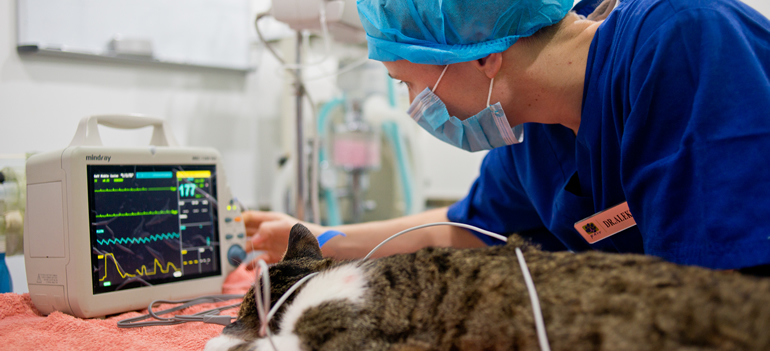VETERINARY SERVICES

All surgeries are performed under local or general anaesthesia. Anaesthesia (loss of sensory feeling) and analgesia (pain relief) are a vital part of the process to ensure your pet is comfortable and safe whilst we perform surgery.
All patients are monitored by a dedicated member of staff, from the start to the finish of the anaesthetic and surgical process.
All surgeries are conducted by a minimum of 3 staff members and often up to 5.
We perform a wide variety of surgeries at SPVC not restricted to the following:
Neutering (AKA desexing, castration, spey) for dogs, cats and male rabbits.
Soft tissue surgery – E.g. Intestinal FB removal, splenectomy, urinary cystotomy, tumour removal, wounds, ophthalmological surgery, diagnostic sampling and anatomical correction for medical (not cosmetic) purposes.
Orthopaedic surgery - fracture repairs, joint salvage operations, amputations and non-cosmetic anatomical correction surgery (e.g. Grade 2 or more congenital patella dislocation correction).
To give you an idea of what goes into a routine surgery, please find the process described below for atypical spey for a young, female dog. As we treat everyone as an individual, it is likely that procedures will vary a little from patient to patient.
1. Every surgical patient needs to have had a history taken and clinical examination in consultation within 6 months of surgery, where the vet has said your pet is fit, healthy and able to undergo anaesthesia and surgery.
2. Staff and client will arrange a surgical appointment for the patient, usually before her first heat or more than 6 weeks and less than 5 months after her last bleeding.
3. No food for a canine patient 8 hours before arrival at the vet clinic. Usually this means dinner the night before and no breakfast the next day. Water should be available at all times.
4. A little walk before arriving at the clinic between 8.30am and 9.30am.
5. Owners will fill out an anaesthetic consent form, discuss any queries regarding the procedure and leave their pet with us for the day.
6. A brief health check will be performed to make sure all is still well.
7. Patient weight recorded so that we can calculate drug doses accurately.
8. Blood taken to ensure no underlying issues.
9. Premedications given for pain relief and antibiosis.
10. Premedication given to sedate the patient. This allows a smooth and safe induction of general anaesthesia (GA) and gives further pre-emptive pain relief.
11. GA induction with a further two drugs.
12. Placement of endotracheal tube to maintain a patent airway, allow control of oxygen and inhaled anaesthetic gas for GA maintenance.
13. Sterile preparation of the surgical site and continue monitoring of the patient’s vital signs.
14. Surgery under sterile conditions.
15. Intra operative pain relief given as necessary.
16. Monitored recovery from GA with the removal of inhaled gas.
17. Carefully monitored until ET tube is out and head is up.
18. Monitored for pain and sent home when able to walk and comfortable.
19. Certain individuals will need an Elizabethan collar to stop them licking at their surgical wound. However, many animals are comfortable after our attention to pre and post operative pain control and do not lick.
20. Lots of rest. On lead outside to go to the toilet and otherwise no walks, play etc untilremoval of sutures 10-14 days post surgery.

